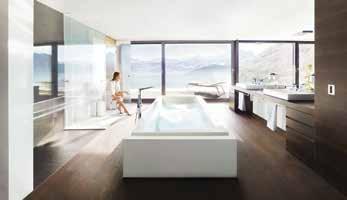
6 minute read
Overhauling Guestrooms
Albert C. Kobayashi Inc. refurbished 1,649 guestrooms at the Sheraton Waikiki. PHOTO COURTESY ACK

Advertisement
ACK renovates 1,649 rooms at the Sheraton Waikiki

BY DAVID PUTNAM PHOTOS COURTESY ACK
To perform a “complete gut rehabilitation” of the Sheraton Waikiki, the second-largest hotel in Hawaii, Albert C. Kobayashi Inc. (ACK) set a goal of turning over 30 to 35 guestrooms for immediate occupancy each week.
The work, which began in January 2019, required ACK to renovate 1,649 rooms along with adjacent corridors and elevator lobbies on floors four through 31 at the massive hotel overlooking Waikiki Beach on Kalakaua Avenue. ACK was scheduled to complete the $140 million job in July for the client, Kyo-ya Hotels and Resorts LP, says Brian Niitani Brian Niitani, project executive for the general contractor.
“Our scope of work was a complete demolition of all existing rooms and lanai, followed by a full bathroom renovation, lanai tile flooring, lanai sliding glass doors, MEP (mechanical, electrical and plumbing) system upgrades, installation of built-in hotel furniture and all associated finishes,” Niitani says.
The Sheraton Waikiki first opened in 1971, and Niitani notes that the previous major renovation at the prop
Each guestroom was completely renovated.
erty was done about 10 years ago to upgrade public and back-of-house areas, the main lobby, ballrooms, common amenities and food service infrastructure.
Updating the guestrooms was the logical next step. Much of the work was done during a time of low occupancy at hotels across the Islands due to the coronavirus outbreak, but when the project launched in January the prop
T H A N K Y O U F O R M A K I N G HAWAII...
THE “D E S T I N AT I O N”

MAHALO SHERATON & ALBERT C KOBAYASHI
MAY GOD BLESS & PROTECT HAWAII

erty was packed with tourists.
“As with any construction project, coordination was the key to success,” Niitani says. “The unique challenge for coordination on this project was that all work had to be coordinated and agreed upon a week prior to starting anything on-site. This pre-coordination allowed the hotel to plan and coordinate their hotel occupancy, which would average 98 percent.”
A few weeks before the project was completed, the COVID-19 pandemic prompted a government-ordered shutdown of visitors to Hawaii, resulting in low occupancy among all Hawaii hotels.
Still, “communication and scheduling amongst team members were of the utmost importance on this project,” Niitani says. “Due to this priority, we conducted daily in-house meetings and bi-weekly owner meetings to review the schedule, coordinate shutdowns and discuss unforeseen conditions. Most of our meetings were conducted on-site to review and resolve issues as they arose.”
ACK’s main construction tasks included: • abatement and demolition, • framing and drywall, • installing exterior sliding doors and exterior lanai divider panels, • plumbing, • fire sprinklers, • electrical, • HVAC, • finish carpentry on new doors, casework and fixed furniture such as wardrobes and divider panels, and • other finishes (paint, carpet and tile).
“Because this project was a renovation of an almost 50-year-old building which had gone through some
upgrades over the years, it was difficult to utilize any as-built drawings for design or construction coordination,” Niitani says. “Once demolition was completed on each floor, there were always new and unique unforeseen conditions that arose. This required the team to do many on-site collaborations so that we could address and resolve the issues immediately and keep the project moving forward.”
The project team, he adds, “utilized Procore for project documentation, and especially for ensuring our field coordination was captured in RFIs.”
Staying on schedule on such a large project brought special challenges. “A key factor to the project’s success, and our most challenging aspect, was the weekly cycle and overall project schedule,” Niitani notes. “Due to the high occupancy of the hotel, any slip in schedule would result in lost revenue for the hotel and potential liquidated damages for ourselves.”
To ensure ACK met its goal of finishing up to 35 guestrooms each week, “the entire project team, inclusive of the owner, construction manager, subcontractors, vendors and
One of the modern and spacious guestrooms ACK, worked on holidays, weekends and made numerous sacrifices to bring this project home on schedule.”


CONGRATULATIONS
Albert C Kobayashi Construction Inc on the completion of the Sheraton Waikiki Guest Room Renovation.
M A H A L O F R O M Y O U R FRIENDS AT FERGUSON.
ferguson.com SUBS & SUPPLIERS
Renovating 1,649 hotel guestrooms in 19 months takes an army of skilled workers and adept suppliers. Brian Niitani, project executive for general contractor Albert C. Kobayashi Inc., praised the team for its work at the Sheration Waikiki.
“All of our subcontractors and suppliers put in countless hours, and the completion of this renovation was a joint effort by everyone involved,” Niitani says. “No one can be singled out as the dedication and commitment shown by this team is what led to the completion and success of the project. Because of that, we would like to recognize them all.” SUBCONTRACTORS A-American Custom Flooring Inc. (tile) A-1 A-lectrician Inc. (electrical) Alakai Mechanical Corp. (HVAC) Coastal Construction Co. Inc. (finish carpentry) Commercial Plumbing Inc. (plumbing and fire sprinklers) Concrete Coring Co. of Hawaii (abatement and demolition) Island Flooring (carpeting and resilient flooring) Kalu Glass Co. Inc. (glazing) Sinclair Drywall Inc. (gypsum board) Zelinsky Co. (painting and wall covering) MAJOR SUPPLIERS Ferguson Enterprises – Hawaii (bath accessories) Island Pacific Distributers Inc. (finish hardware) Newport Pacific Cabinets Inc. (doors)
The bath in one of the updated guestrooms

Along with Niitani, the project team included Cyrus Oda, Nobutada Nagai and Yasuhiko Ishikawa of Kyo-ya; Tom Calame and Harzali Hashim of hotel operator Marriott International Inc.; Cassie Idehara, Jared Wakayama and James Lewis of construction manager Rider Levett Bucknall; and Benjamin Woo, Masato Tochika, Melvin Nakaoka, Nicole Ford and Brandon Fujimura of Benjamin Woo Architects.
“As we wrap up the project,”
A view from the lanai of a guestroom at the Sheraton Waikiki.

Niitani says, “the client has relayed only positive feedback from themselves, guests and travel agencies.”
The project’s outstanding feature, according to Niitani: “The sheer quantity of rooms that were renovated.
“Sheraton Waikiki has the most hotel rooms in one building of any hotel in the state,” he adds, “and a complete renovation of 1,649 rooms over 19 months is an amazing feat in and of itself that we attribute to a cohesive project team. “ACK would like to acknowledge the entire project team staff from the owners, hotel staff, subcontractors, vendors and our employees for a successful project. We acknowledge the countless hours and hard work that was contributed by all.
“Their determination and outstanding work ethic made this project a success for ACK and all those involved.”






